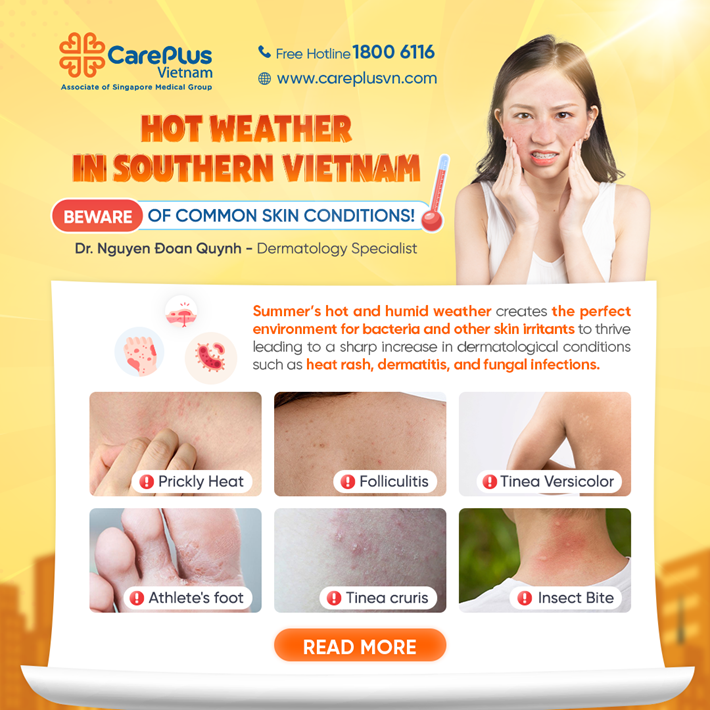COMMON SUMMER SKIN CONDITIONS AND HOW TO PREVENT THEM EFFECTIVELY

7/4/2025 3:09:14 PM
COMMON SUMMER SKIN CONDITIONS AND HOW TO PREVENT THEM EFFECTIVELY
Summer brings more than just brilliant sunshine and sudden rain showers—it also introduces an unwelcome feature: prolonged hot and humid weather. The combination of high humidity and rising temperatures creates the perfect environment for bacteria and fungi to thrive. Meanwhile, overactive sweat glands can lead to a variety of skin issues.
This article will help you recognize common summer skin conditions and provide effective tips for prevention and treatment.
1. Heat Rash (Miliaria Rubra or Prickly Heat)
A familiar issue during hot weather, especially among children and those who are physically active.
-
Causes: Blocked sweat ducts. When sweat becomes trapped beneath the surface of the skin, it leads to inflammation and small red bumps.
-
Symptoms: Tiny red bumps or small blisters causing itching or a prickling sensation. Commonly affects sweat-prone areas like the forehead, neck, chest, back, and skin folds.
-
Prevention and Treatment:
-
Stay cool: Wear loose-fitting, breathable clothes made from absorbent fabrics like cotton. Avoid outdoor activities during peak heat.
-
Good hygiene: Bathe regularly with cool water. Use gentle, non-irritating cleansers.
-
Keep skin dry: Gently pat the skin dry after bathing. Avoid heavy creams that can clog pores.
2. Folliculitis
An inflammation of the hair follicles, commonly caused by bacteria (especially Staphylococcus aureus) or fungi.
-
Causes: Excessive sweating, friction from tight clothing, improper shaving, and humid environments encourage microbial overgrowth.
-
Symptoms: Small red bumps or pustules around hair follicles that may itch or be mildly painful. Commonly found on the back, chest, thighs, buttocks, and underarms.
-
Prevention and Treatment:
-
Personal hygiene: Shower daily, especially after sweating or exercising.
-
Clothing: Choose loose, breathable garments.
-
Treatment: Mild cases may resolve with good hygiene. More severe infections may require antibacterial or antifungal soaps and topical medications prescribed by a doctor.
3. Tinea Versicolor (Pityriasis Versicolor)
A common fungal skin infection in tropical climates caused by the overgrowth of the yeast Malassezia furfur.
-
Causes: This yeast lives naturally on the skin but can overgrow in oily skin, excessive sweating, and humid conditions.
-
Symptoms: Discolored patches (white, pink, or light brown) that may merge into larger areas with fine, flaky scales. Typically appears on the chest, back, shoulders, and neck. May itch mildly when exposed to sunlight or during sweating.
-
Prevention and Treatment:
-
Treatment: Use antifungal shampoos, washes, or creams containing agents such as ketoconazole or selenium sulfide as directed. Severe cases may require oral antifungal medication.
-
Prevention: Keep the skin dry. Wear sweat-absorbing, breathable clothing.
4. Intertriginous Fungal Infections (e.g., Athlete’s Foot, Jock Itch)
-
Causes: Caused by dermatophyte fungi, which thrive in warm, moist areas. Wearing closed shoes all day, damp socks, or tight underwear are key risk factors.
-
Symptoms:
-
Athlete’s Foot (Tinea Pedis): Peeling, cracking, oozing, and itching between the toes, especially the outer ones.
-
Jock Itch (Tinea Cruris): Itchy, ring-shaped red patches in the groin area with well-defined borders.
-
Prevention and Treatment:
-
Keep dry: Thoroughly dry between toes and the groin area after bathing.
-
Proper attire: Use open-toe footwear or shoes with ventilation. Wear clean cotton socks daily and loose, absorbent underwear.
-
Treatment: Apply topical antifungal creams as prescribed. Continue using medication for the full treatment period, even if symptoms disappear, to prevent recurrence.
5. Insect-Related Contact Dermatitis
Summer—especially after rain—encourages insect proliferation.
-
Causes: Skin reactions due to exposure to insect toxins (e.g., rove beetles) or bites from mosquitoes, fleas, and others.
-
Symptoms:
-
Rove beetle dermatitis: Red, streaky or patchy skin lesions with small pustules and a burning sensation.
-
Other insect bites: Raised, itchy hives. Scratching can lead to infection.
-
Prevention and Treatment:
-
Immediate care: If a rove beetle lands on your skin, gently blow it off or remove it with a piece of paper—do not crush it. Clean the area with saline solution.
-
Prevention: Keep your living space clean and free of overgrown plants. Close doors in the evening and use balcony lights to divert insects. Use safe mosquito repellents.
🌞 Golden Rules for Summer Skin Health
-
Maintain hygiene: Shower at least once a day, especially after sweating.
-
Keep skin dry: Dry thoroughly after bathing, especially in skin folds.
-
Wear suitable clothing: Opt for lightweight, breathable fabrics like cotton and linen.
-
Sun protection: Use sunscreen and protective clothing like hats and long sleeves.
-
Stay hydrated: Drink plenty of water to keep your skin healthy from the inside out.
🚨 When to See a Dermatologist
Most of the above conditions can be managed at home if mild. However, see a dermatologist immediately if you notice:
-
Rapidly spreading rash
-
Signs of serious infection: swelling, redness, pus, pain
-
Uncontrollable itching that disrupts sleep or daily life
-
Accompanied by systemic symptoms such as fever, chills, or fatigue
-
No improvement after a few days of self-care
By taking proactive steps to care for your skin, you can fully enjoy a vibrant and worry-free summer.